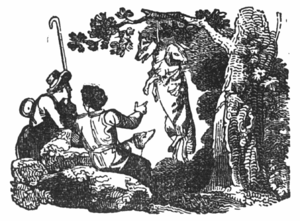- Matthew 7:15
-
Matthew 7:15 is the fifteenth verse of the seventh chapter of the Gospel of Matthew in the New Testament and is part of the Sermon on the Mount. This verse begins the section warning against false prophets.
In the King James Version of the Bible the text reads:
- Beware of false prophets, which come to you in sheep's
- clothing, but inwardly they are ravening wolves.
The World English Bible translates the passage as:
- “Beware of false prophets, who come to you in
- sheep’s clothing, but inwardly are ravening wolves.
For a collection of other versions see BibRef Matthew 7:15
The metaphor
The metaphor of 'a wolf in sheep's clothing' has become a common English expression. It is alluded to in Romeo and Juliet, where a character is called a "wolvish ravening lamb."[1] See The Wolf in Sheep's Clothing for some other cultural uses of the phrase.
Sheep were an important part of life in Palestine of Jesus' era, and the metaphor of the pious as a flock of sheep is a common one in both the Old and New Testaments. Wolves were regarded as greedy and malevolent predators who were a threat to the innocent, and such wolf metaphors are also found in several other parts of the Bible. Schweizer feels this metaphor may be linked to the traditional description of the prophets being clad in skins.[2]
It is an open question who, if anyone, this verse is directed against. At the time the gospel was written the Christian communities had several opponents, who may be being targeted by the author of Matthew in this verse. Davies and Allison note several groups that scholars have proposed. There are several false prophets mentioned in the literature of the period such as Simon Magus and Bar Kokba, but the text has no hint that it referring to one of these in particular. France notes that the wording refers to the prophets coming to you implies that these prophets are from outside the community of disciples.[3] The Pharisees are the primary opponent of the righteous through the Gospel of Matthew, and this could be another attack on them. However, Matthew 7:22 seems to make clear that the false prophets are Christian rather than Jewish. This also could rule out other Jewish sects active in this period such as the Essenes and Zealots. While in later years Christian groups such as the Gnostics would become prominent rivals to mainstream Christianity, Gnosticism was not yet a major concern at the time this Gospel was written.[4] Scholars who see a rivalry between the Jewish Christianity of Mathew and the wider gospel of St. Paul have read this verse as an attack on Pauline Christianity..[5][6] Schweizer supports the notion that the idea of false prophets is closely attached to eschatology, and that this passage refers to events expected to occur in the end times, not to any current rivals.[7] False prophets were a frequent concern in the Old Testament, such as in Jeremiah. France believes that even without any current threats the history in the Old Testament would lead Jesus to be concerned about the dangers of false prophets.[8] The figures in Matthew 7:21-22 are themselves surprised to be judged harshly, but the word inwardly makes clear that prophets in this verse are knowing deceivers of the faithful.[9]
References
- ^ Hamlin, Hannibal. "William Shakespeare." The Blackwell companion to the Bible in English literature ed. Rebecca Lemon. John Wiley and Sons, 2009 pg. 231
- ^ Schweizer, Eduard. The Good News According to Matthew. Atlanta: John Knox Press, 1975
- ^ France, R.T.. The Gospel of Matthew. Wm. B. Eerdmans Publishing, 2007 pg. 290
- ^ Davies, W.D. and Dale C. Allison, Jr. A Critical and Exegetical Commentary on the Gospel According to Saint Matthew. Edinburgh : T. & T. Clark, 1988-1997.
- ^ Nolland, John. The Gospel of Matthew: a commentary on the Greek text. Wm. B. Eerdmans Publishing, 2005 pg. 198
- ^ Harrington, Daniel J. The Gospel of Matthew. Liturgical Press, 1991 pg. 335
- ^ Schweizer, Eduard. The Good News According to Matthew. Atlanta: John Knox Press, 1975
- ^ France, R.T.. The Gospel of Matthew. Wm. B. Eerdmans Publishing, 2007 pg. 289
- ^ France, R.T.. The Gospel of Matthew. Wm. B. Eerdmans Publishing, 2007 pg. 290
Gospel of Matthew Preceded by:
Matthew 7:14Chapter 7 Followed by:
Matthew 7:16Categories:- Gospel of Matthew verses
- Sermon on the Mount
Wikimedia Foundation. 2010.

